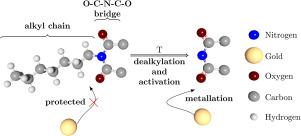Metal–organic coordination with thermally controlled protection
IF 3.9
2区 材料科学
Q2 MATERIALS SCIENCE, MULTIDISCIPLINARY
引用次数: 0
Abstract
The field of On-Surface Synthesis, which involves creating two-dimensional structures by covalently coupling simple molecules directly on surfaces, has seen remarkable advancements in the past decade, with new synthetic methods constantly emerging. The inherent constraints of working in two dimensions and the inability to use solutions for precursor exchange and byproduct removal are slowing down progress. Recent breakthroughs, such as using atomic hydrogen to remove byproducts and synthesize radicals on surfaces, have shown promise.
Drawing inspiration from traditional chemistry, we introduce the concept of protective groups to gain greater control over on-surface reactions. Specifically, we demonstrate the chemical protection of an imide group by attaching an alkyl functional group to a [5]phenacenediimide molecule. This protection strategy effectively delays the metal coordination of the imide group until the significantly higher temperature at which the alkyl group detaches. Furthermore, the volatile nature of the alkyl byproducts allows for their inherent removal, facilitates clean surfaces. Our findings successfully illustrate the potential of using protective groups as a powerful tool to further direct and refine On-Surface Synthesis.

金属有机配位,热控保护
在过去的十年里,随着新的合成方法不断出现,表面合成领域取得了显著的进步,它涉及通过直接在表面上的简单分子共价偶联来创建二维结构。二维工作的固有限制以及无法使用溶液进行前体交换和副产物去除正在减缓进展。最近的突破,如利用氢原子去除副产物和在表面上合成自由基,显示出了希望。从传统化学中汲取灵感,我们引入了保护基团的概念,以更好地控制表面反应。具体来说,我们通过将烷基官能团连接到[5]苯二亚胺分子上来证明亚胺基团的化学保护作用。这种保护策略有效地延迟了亚胺基团的金属配位,直到烷基基团分离的温度明显更高。此外,烷基副产物的挥发性允许其固有的去除,有利于清洁表面。我们的发现成功地说明了利用保护基团作为进一步指导和完善表面合成的有力工具的潜力。
本文章由计算机程序翻译,如有差异,请以英文原文为准。
求助全文
约1分钟内获得全文
求助全文
来源期刊

Vacuum
工程技术-材料科学:综合
CiteScore
6.80
自引率
17.50%
发文量
0
审稿时长
34 days
期刊介绍:
Vacuum is an international rapid publications journal with a focus on short communication. All papers are peer-reviewed, with the review process for short communication geared towards very fast turnaround times. The journal also published full research papers, thematic issues and selected papers from leading conferences.
A report in Vacuum should represent a major advance in an area that involves a controlled environment at pressures of one atmosphere or below.
The scope of the journal includes:
1. Vacuum; original developments in vacuum pumping and instrumentation, vacuum measurement, vacuum gas dynamics, gas-surface interactions, surface treatment for UHV applications and low outgassing, vacuum melting, sintering, and vacuum metrology. Technology and solutions for large-scale facilities (e.g., particle accelerators and fusion devices). New instrumentation ( e.g., detectors and electron microscopes).
2. Plasma science; advances in PVD, CVD, plasma-assisted CVD, ion sources, deposition processes and analysis.
3. Surface science; surface engineering, surface chemistry, surface analysis, crystal growth, ion-surface interactions and etching, nanometer-scale processing, surface modification.
4. Materials science; novel functional or structural materials. Metals, ceramics, and polymers. Experiments, simulations, and modelling for understanding structure-property relationships. Thin films and coatings. Nanostructures and ion implantation.
 求助内容:
求助内容: 应助结果提醒方式:
应助结果提醒方式:


